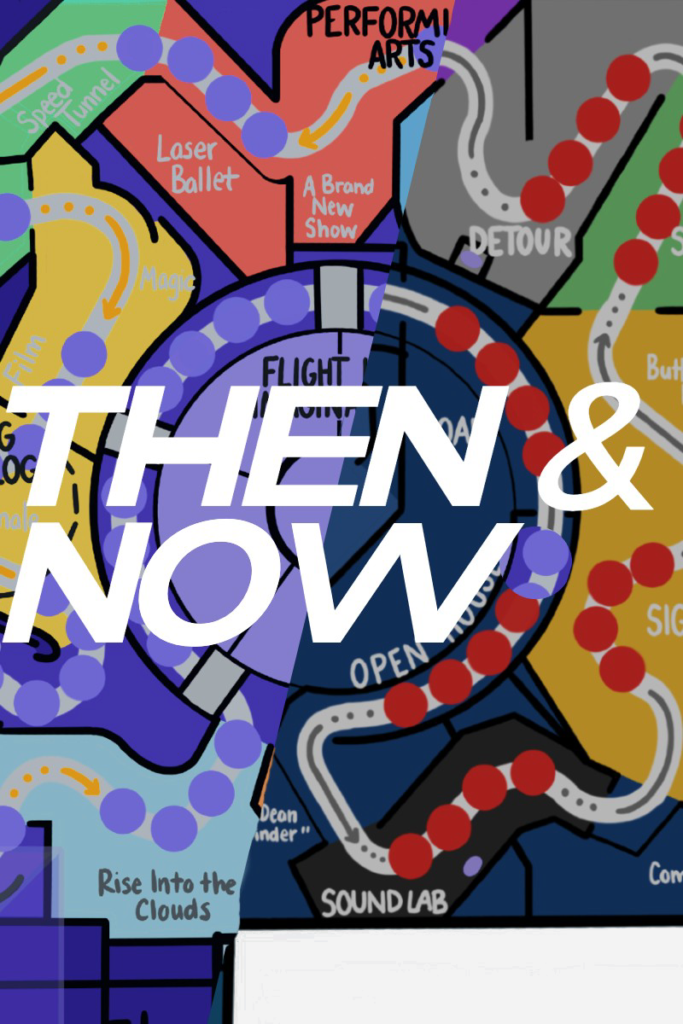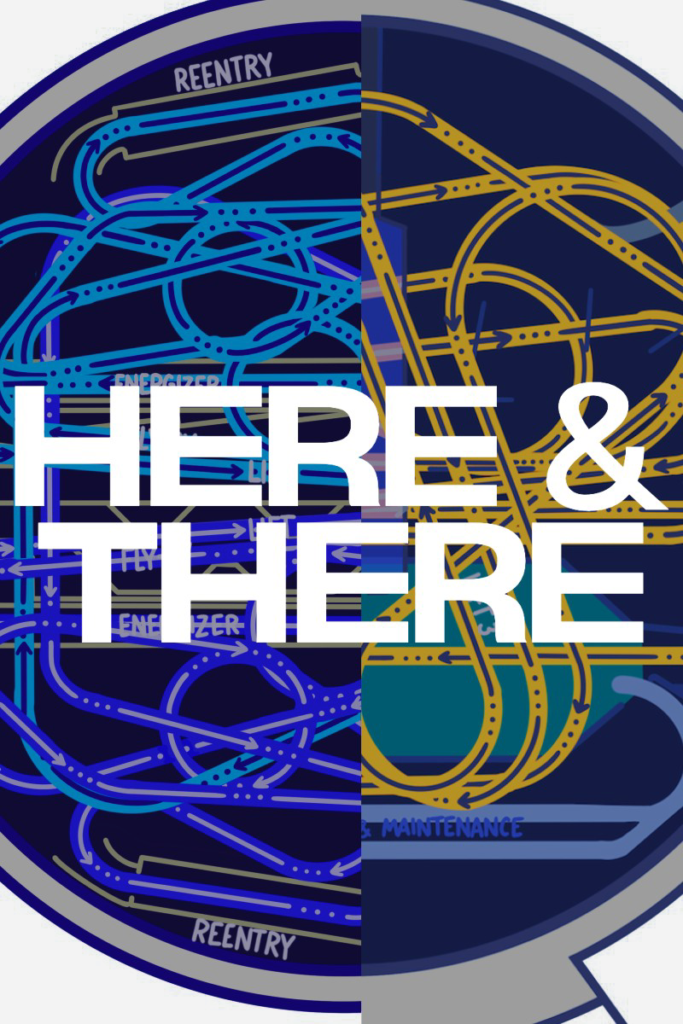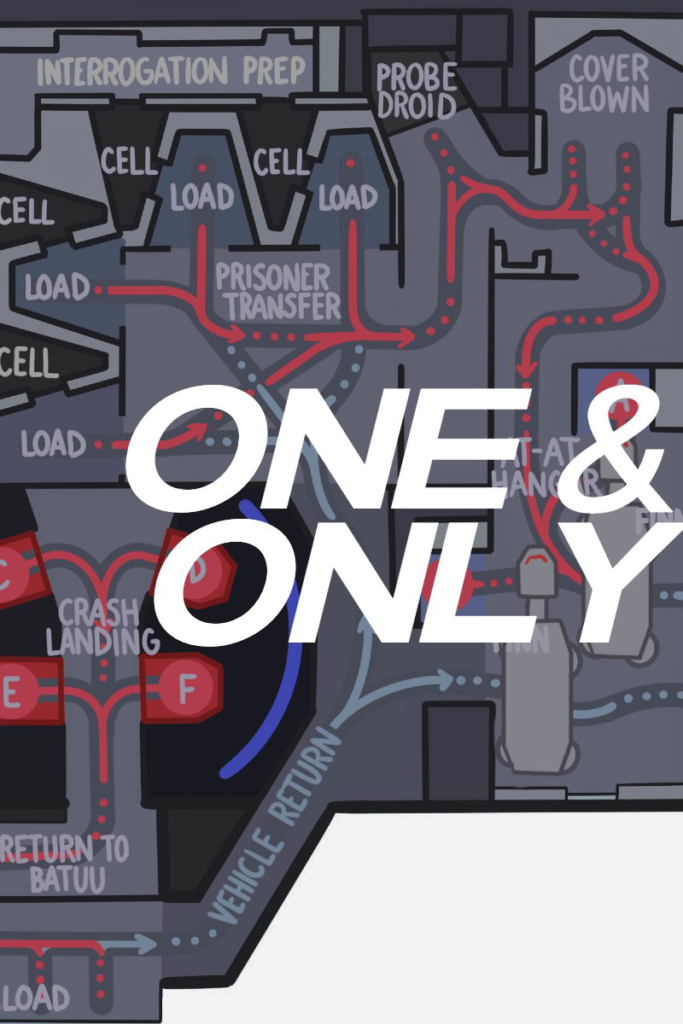By now you might’ve noticed that Park Lore is all about seeing theme parks differently. In over a hundred in-depth stories, we’ve covered the tales of Lost Legends, Modern Marvels, Declassified Disasters, and never-built Possibilitylands from across the world and industry. In other words, I love an 8,000 word deep dive into the making of an Imagineering classic… but sometimes the best way to understand an attraction is to see how it all fits together.
Earlier this year, I published THEN & NOW – a collection of 50 hand-illustrated ride layouts to compare the before-and-after of Disney and Universal’s most legendary closed attractions and their modern-day replacements. You made my year by sharing those layouts, asking to use them in your own projects, and even becoming supporting Members at Park Lore for $2 a month or more to help sustain this ad-free, clickbait-free, quality-over-quantity theme park storytelling project.
Because of the support of Park Lore Members, I’m able to introduce my next batch of ride layouts that I hope can “paint the picture” of another subset of Disney Parks attractions – the ones shared between HERE & THERE. The sets of rides below reveal just how much rides can evolve as they travel around the world, adapting to new spaces, new parks, new budgets, and even new cultures.
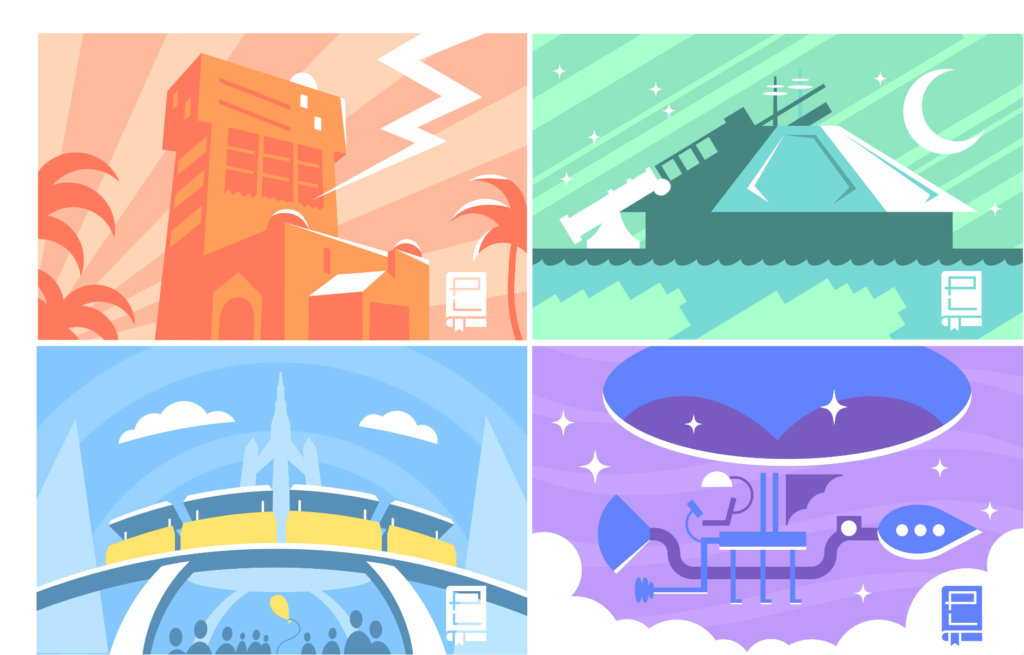
Before we jump in, a quick request! Each of the 100+ ride layouts you’ll find in these collections was hand-illustrated by me with a lot of time and love. I hope you zoom in, slide-to-compare, download, explore, and share them, but please be kind and cite Park Lore, tag me (@themeparklore), and link to this story if you do!
Since Park Lore is ad-free (and clickbait-free!), I proudly make $0 in ad revenue. So if you appreciate Park Lore’s in-depth, interconnected theme park storytelling and analysis, consider becoming a Member for as little as $2 / month! Members can unlock rare concept art in every story, audio streams, 100+ Extra Features, and more!
1. Scary Adventures
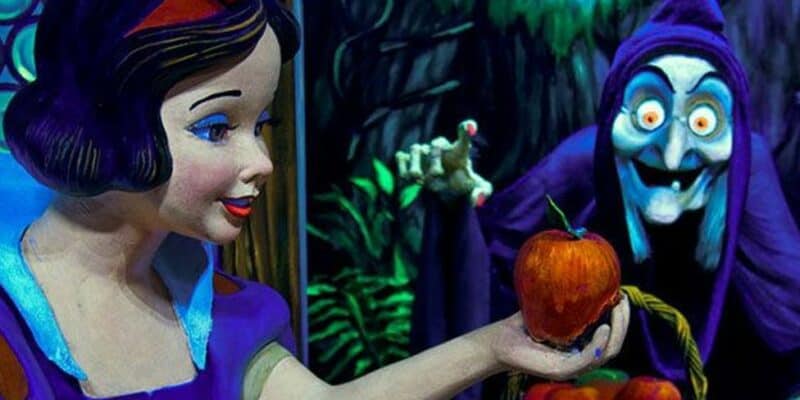
Both Disneyland and Magic Kingdom featured classic Fantasyland dark rides themed to Walt Disney’s first full-length animated film among their lists of Opening Day Originals, but they were very different rides. Major redesigns (in 1983 and 1994, respectively) brought the two into alignment with several shared scenes and similar, spooky tones. But even once both were renamed “Snow White’s Scary Adventures,” they still included some different scenes, in different orders.
Neither Magic Kingdom nor Disneyland features a ride called “Snow White’s Scary Adventures” today. Magic Kingdom’s version of the ride closed in 2012 to become the Princess Fairytale Hall meet-and-greet space, with the nearby Seven Dwarfs Mine Train stepping into its spiritual shoes. At Disneyland, the ride closed for a facelift in 2020, re-emerging in 2021 as Snow White’s Enchanted Wish (whose layout you can compare to its “Scary” predecessor in our THEN & NOW series). But here’s how California and Florida’s rides compared when they existed…
A. Snow White’s Scary Adventures (Disneyland, 1983 – 2020)
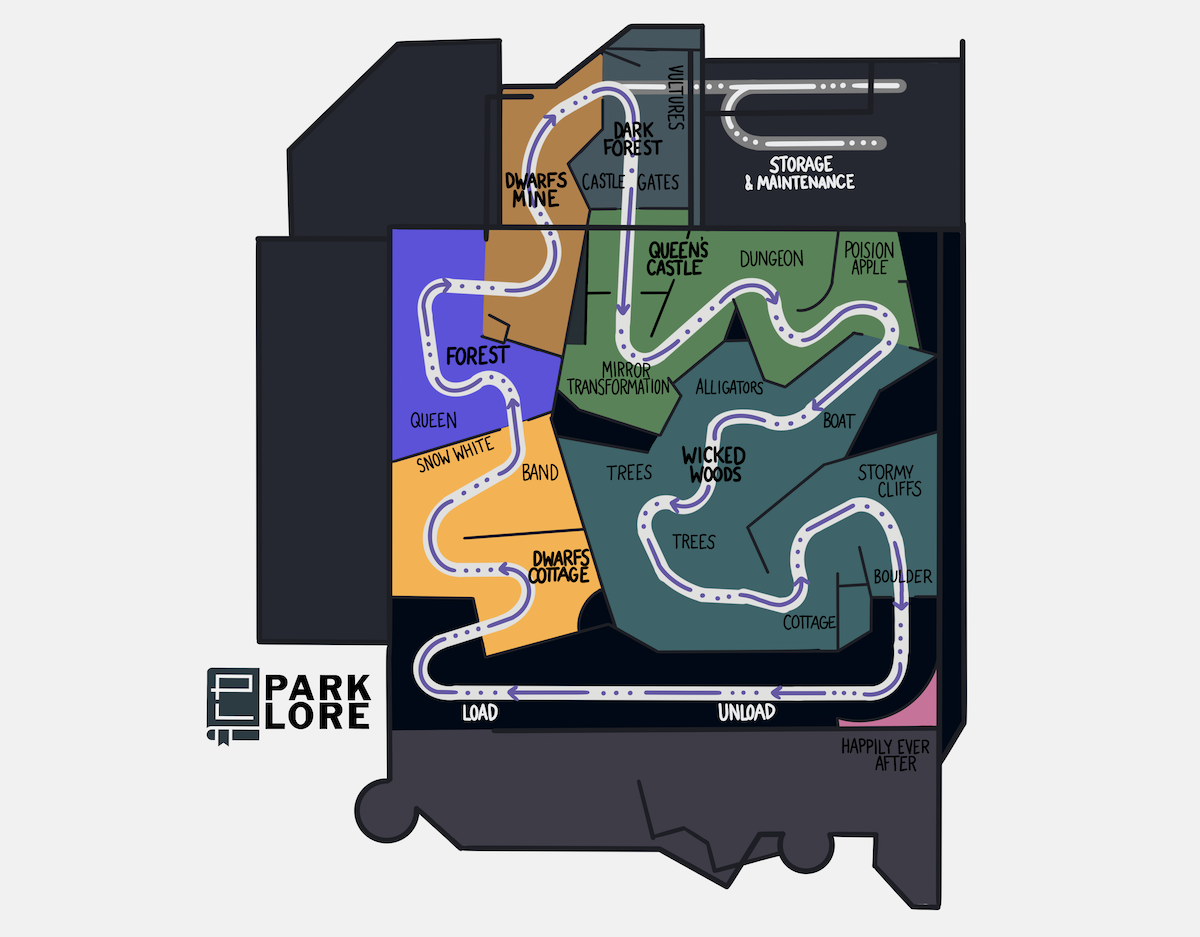
Using the limited space available in the diminutive Disneyland, California’s ride passed through the Dwarfs’ Cottage and Mines, then into the Queen’s Castle. Spooky scenes of dark dungeons, cursed potions, and the Queen’s how’d-they-do-that transformation into the Wicked Witch startled a generation. To make matters worse, the ride’s madcap finale sent guests humming through the gnarled, Wicked Woods where – with a strike of lightning on a stormy cliff – the Witch met her untimely end… Famously, only a mural in the unload area even reminded guests that Snow White had her “happy ending” come true, with riders left quaking from the witch’s relentless pursuit.
Snow White’s Scary Adventures (Magic Kingdom, 1994 – 2012)
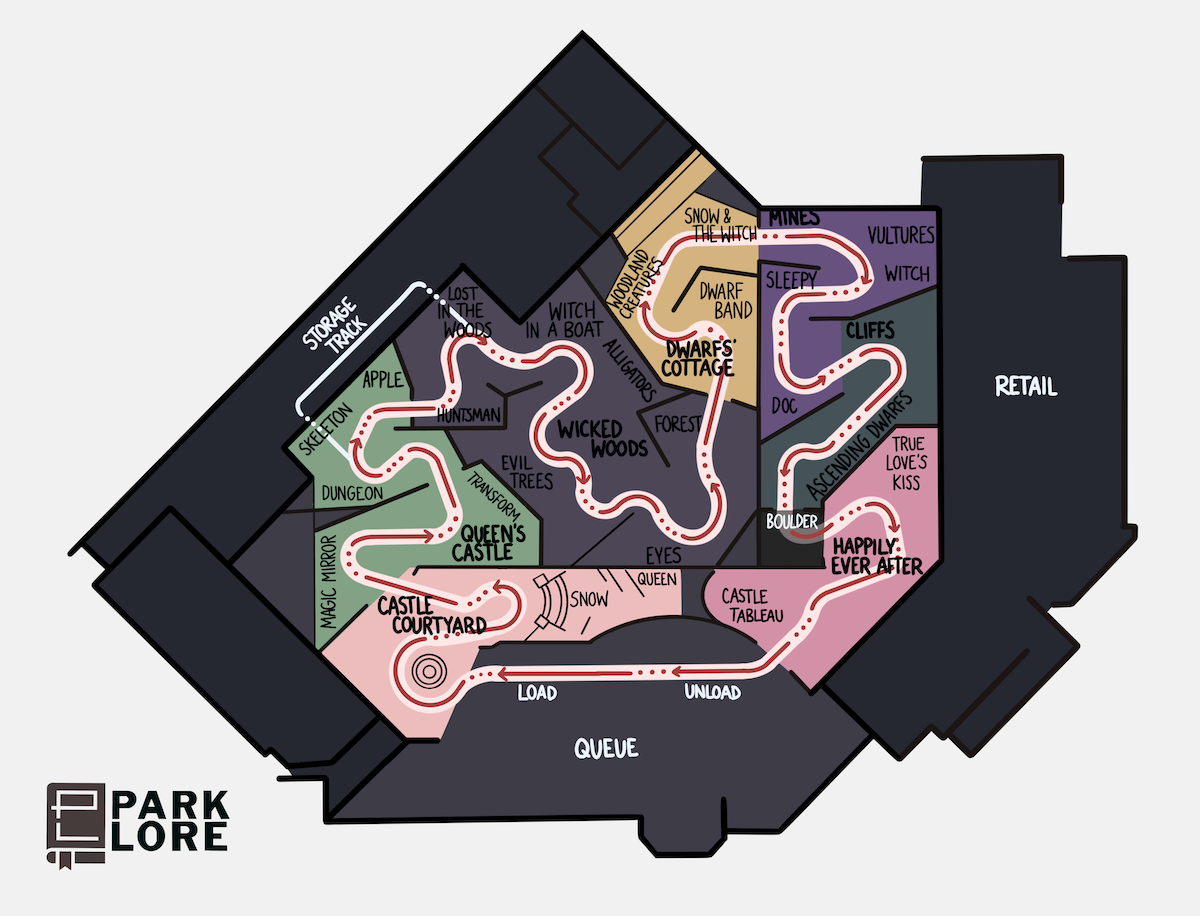
When Magic Kingdom’s version of the ride was redesigned in 1994 (replacing a genuinely frightening, jump-scare-style spook house ride-through of the story), it was the fourth and final of Disney’s Snow White dark rides to fall in line with the versions in California (1983), Japan (1983), and France (1992). It was also the largest, using Magic Kingdom’s size to include a pleasant introductory scene in the Castle Courtyard and a full-fledged Happily Ever After finale. So even if it borrowed several key scenes and gags that Disneyland had debuted a decade earlier, there’s no question that Magic Kingdom’s ride was unique.
We celebrated Magic Kingdom’s closed version of the ride (and explored the entire history of how it changed) in a full Lost Legend: Snow White’s Scary Adventures feature. But it just goes to show that between “Here & There,” the “same” ride can look very different… And of course, that’s just the beginning.
2. Space Mountains
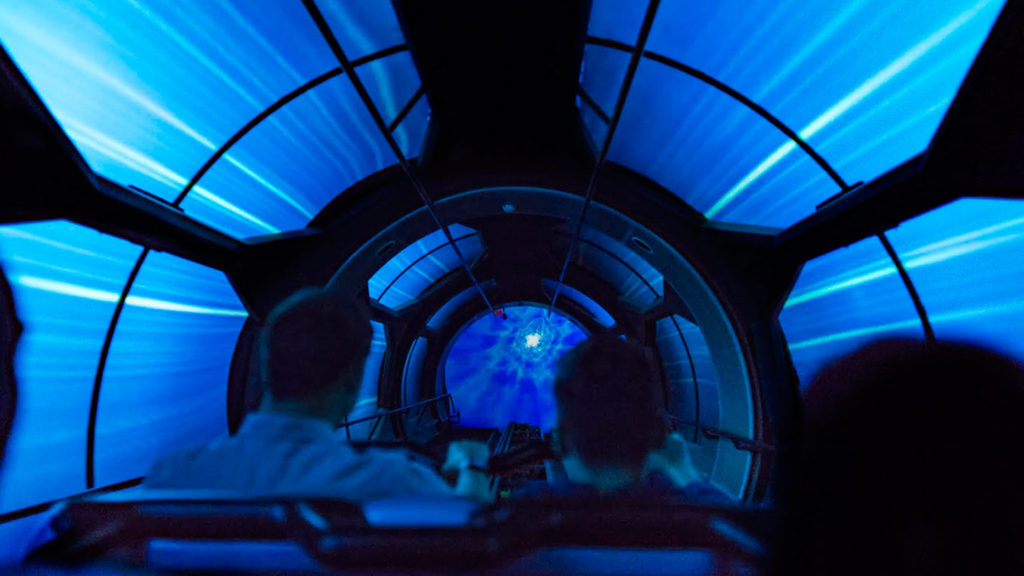
Almost every one of Disney’s “Castle Parks” has a Space Mountain, but none of them are exactly alike. In general, there are three main “models” of Space Mountain out there… and yes, you really can trace the ride’s convoluted path through the darkness of the cosmos on these layouts below, but you may want to tap each one to zoom in and get a closer look.
A. Space Mountain (Magic Kingdom, 1975)
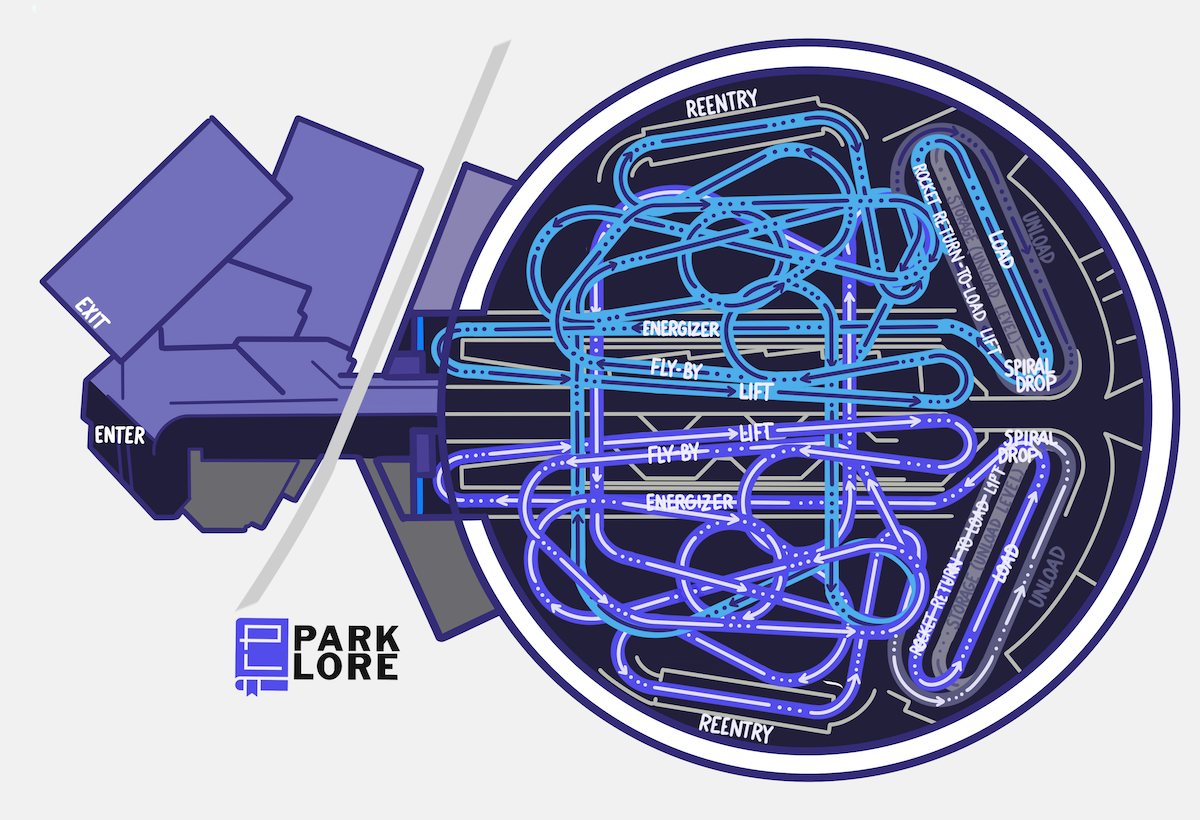
The ’70s were a landmark era for roller coasters, when a “Second Golden Age” spawned a generation of steel classics. Magic Kingdom’s Space Mountain is one of them. It’s often said that Walt Disney World’s version of the ride was “based on” the Matterhorn that had opened in California 16 years earlier. That’s undoubtedly true since both have two tracks, a single central lift hill, and tandem bobsled-style trains… but their layouts don’t really have much in common. (You can see Matterhorn’s layout first-hand in my next batch of ride layouts, ONE & ONLY.)
Magic Kingdom’s two tracks (“Alpha” and “Omega”) are nearly-exact mirror images of one another. Despite an anxiety-inducing climb up a central lift hill through a “space station,” neither track features a significant “big drop.” Instead, the ride’s course focuses on straightaways, bunny hops, helices, and the sensation of flying wildly among the stars. Though many families recall the pulse-pounding, scream-your-head-off speed, it’s mostly an illusion strengthened by the darkness; Magic Kingdom’s Space Mountain tops off at 27 miles per hour – about the speed limit in a residential neighborhood.
Also unique: Magic Kingdom’s twin coasters unload directly below the space where they load. After guests have disembarked, the empty trains turn the corner and climb a lift hill that carries them back up to the load level.
B. Space Mountain (Disneyland, 1977)
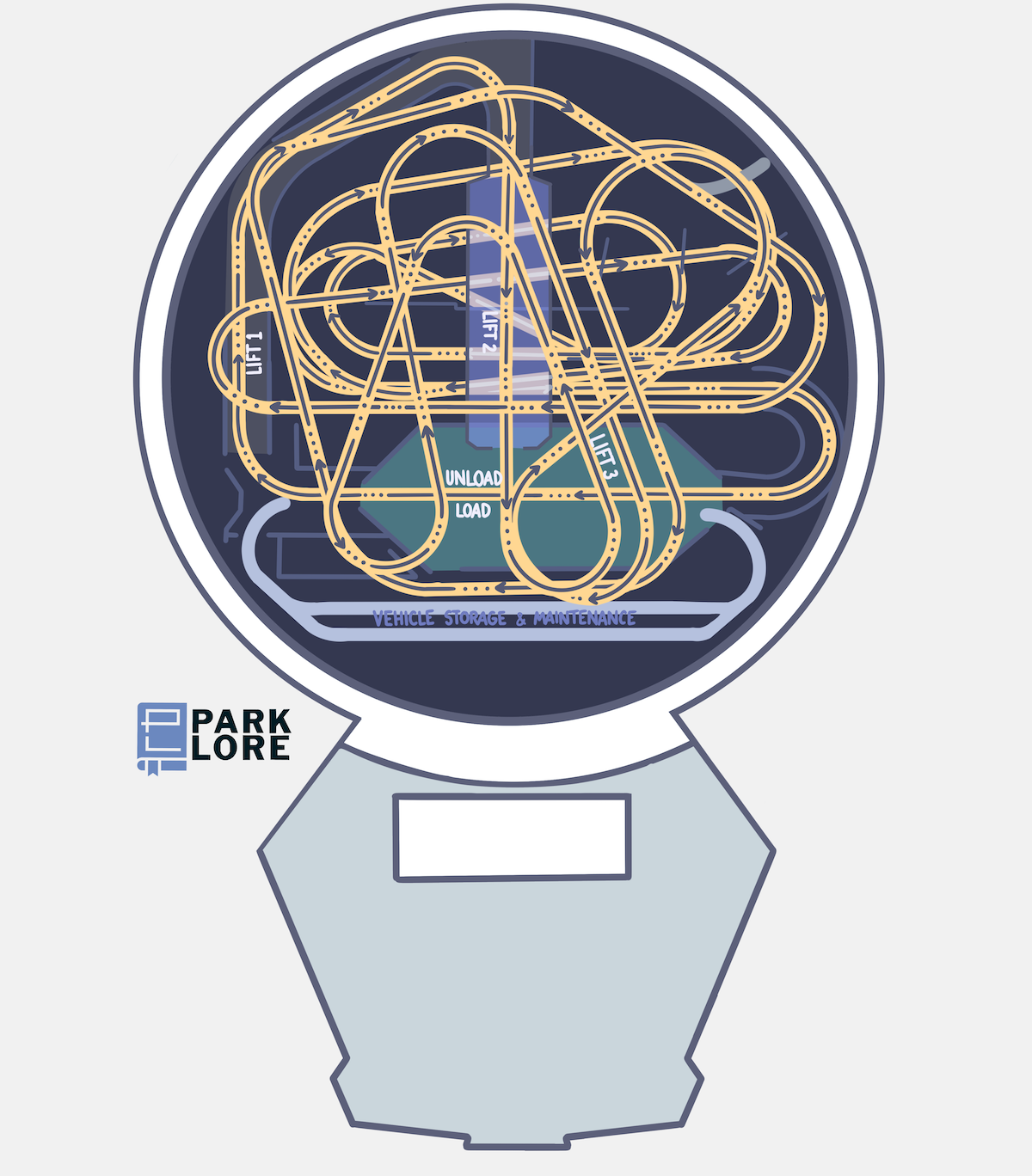
Obviously, Space Mountain was a massive hit whose duplication back at Disneyland was assured. There was just one problem: since Disneyland already has the Matterhorn, it wouldn’t make sense to copy Magic Kingdom’s dual-tracked, bobsled-style coaster back to California. Instead, the ride was redesigned as a single-tracked coaster that’s slightly longer and faster than Florida’s, with a single load / unload station, side-by-side seating, and a three-tier, mostly-enclosed lift hill. Disneyland’s version of the ride has essentially become the “de facto” Space Mountain, having been duplicated in Tokyo and Hong Kong.
With just a single coaster inside, Disneyland’s physical “mountain” has a much smaller footprint than Disney World’s – about half the diameter. It’s also intentionally sunken into the ground to keep the peak from peeking over Main Street in the very compact park. (In Disneyland, Space Mountain is “inside” the park’s berm versus Magic Kingdom, where guests pass under the Railroad to reach it.) The mountain appears ever smaller than it is since the Magic Eye Theater (formerly home to the Lost Legend: Captain EO) is positioned in front of it. Guests queue on the theater’s roof before descending down into the mountain.
Disneyland’s version of the ride was also disassembled and rebuilt from scratch for the park’s 50th Anniversary in 2005. The “new” Space Mountain’s layout is unchanged from the old, but it does feature synchronized on-board audio by Michael Giacchino, a projection-enclosed lift hill, and projection capability throughout the peak – all great tools for seasonal overlays like Space Mountain: Ghost Galaxy and Star Wars Hyperspace Mountain.
C. Space Mountain: De la Terre á la Lune (Disneyland Paris, 1995)
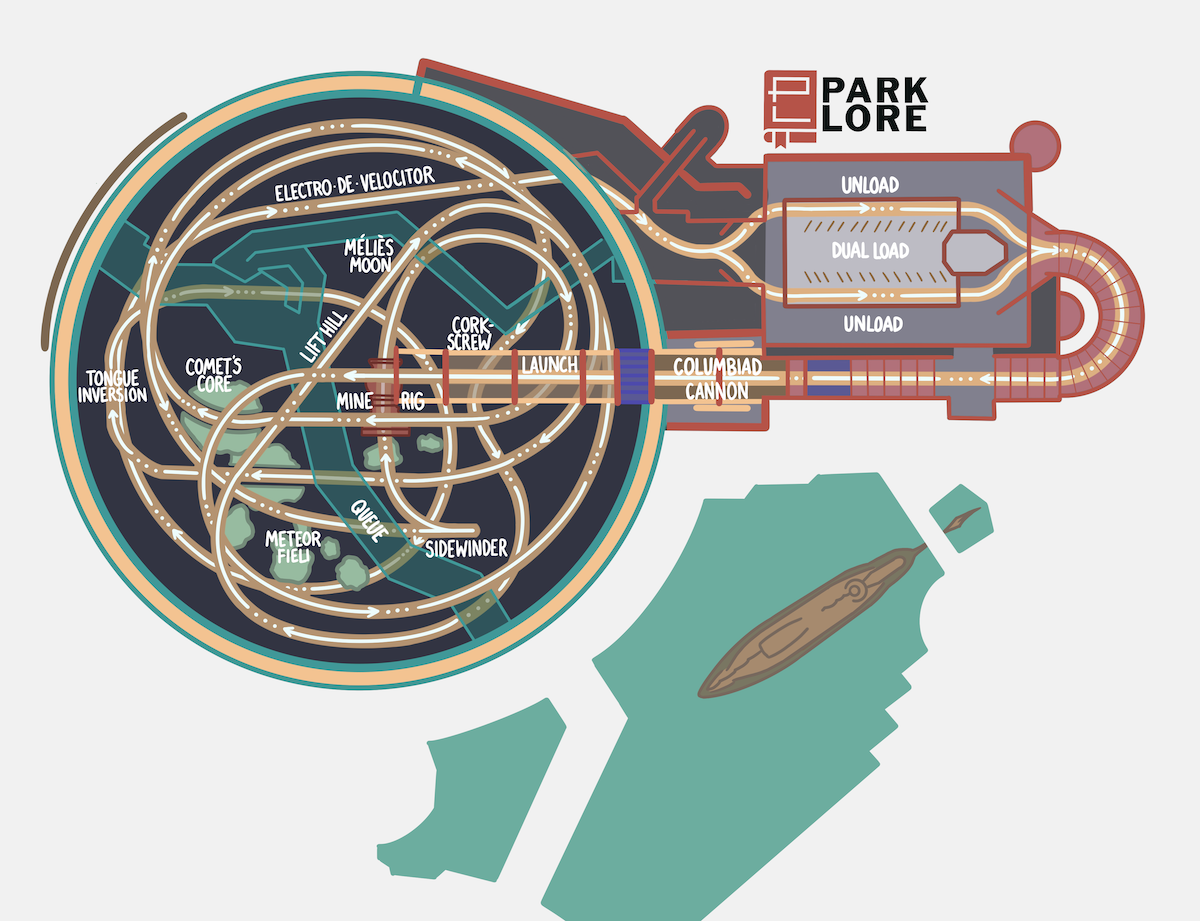
There’s another Space Mountain, too, but it’s not like any of the others. When Disneyland Paris opened in 1992, designers had to strike a careful balance of paying homage to “classic” Disney rides while reimagining them for a very different culture. Since a “Space Age” mountain of mid-century Americana, Googie architecture, and NASA rockets wouldn’t resonate, designers instead crafted the Lost Legend: Space Mountain – De la Terre á la Lune.
A complete reinvention of what a “Space Mountain” could be, Paris’ ride was designed around Jules Verne’s novel From the Earth to the Moon. In an outdoor, sunlit station, riders load into golden, steampunk trains, then drop into the bronze muzzle of the Columbiad Cannon positioned along the copper mountain’s exterior. To the swirling score of an orchestral arrangement (one of the first synchronized onboard audio tracks on a roller coaster), they launch upwards, diving into the peak and racing through a course that includes three inversions.
Naturally, this fantastical, European Space Mountain is the subject of a Lost Legend feature on Park Lore because a decade after opening, the ride was “upgraded” to Space Mountain: Mission 2, dropping the interior aesthetic and sounds of Jules Verne and adapting the same general sci-fi motif as every other Space Mountain. Even weirder, in 2017 it was converted into Star Wars Hyperspace Mountain: Rebel Mission, though no one’s yet been able to figure out why getting to “a galaxy far, far away” begins with being launched out of a golden cannon.
3. Mummified Marvels
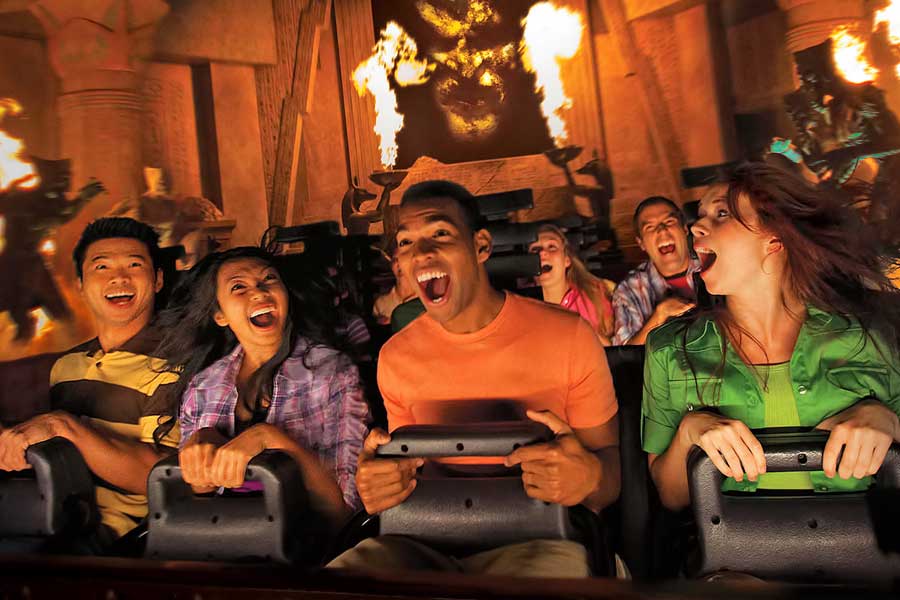
There are three Revenge of the Mummy rides out there (in Orlando, Hollywood, and Singapore), but depending on which Universal Park you visit, a ride on Revenge of the Mummy may end up being the highlight of your day, or earn a resounding “meh.”
A. Revenge of the Mummy (Universal Studios Florida, 2004)
Without a doubt, Universal Studios Florida’s version of Revenge of the Mummy is the definitive form of the ride. That’s largely due to the fact that it occupies the space formerly held by the Lost Legend: Kongfrontation – a very, very big ride. The 62,000 square foot soundstage is six stories tall, which is enough to house not only the substantial dark ride scenes that serve as Mummy’s intro, but a fairly sizable indoor coaster as its core.
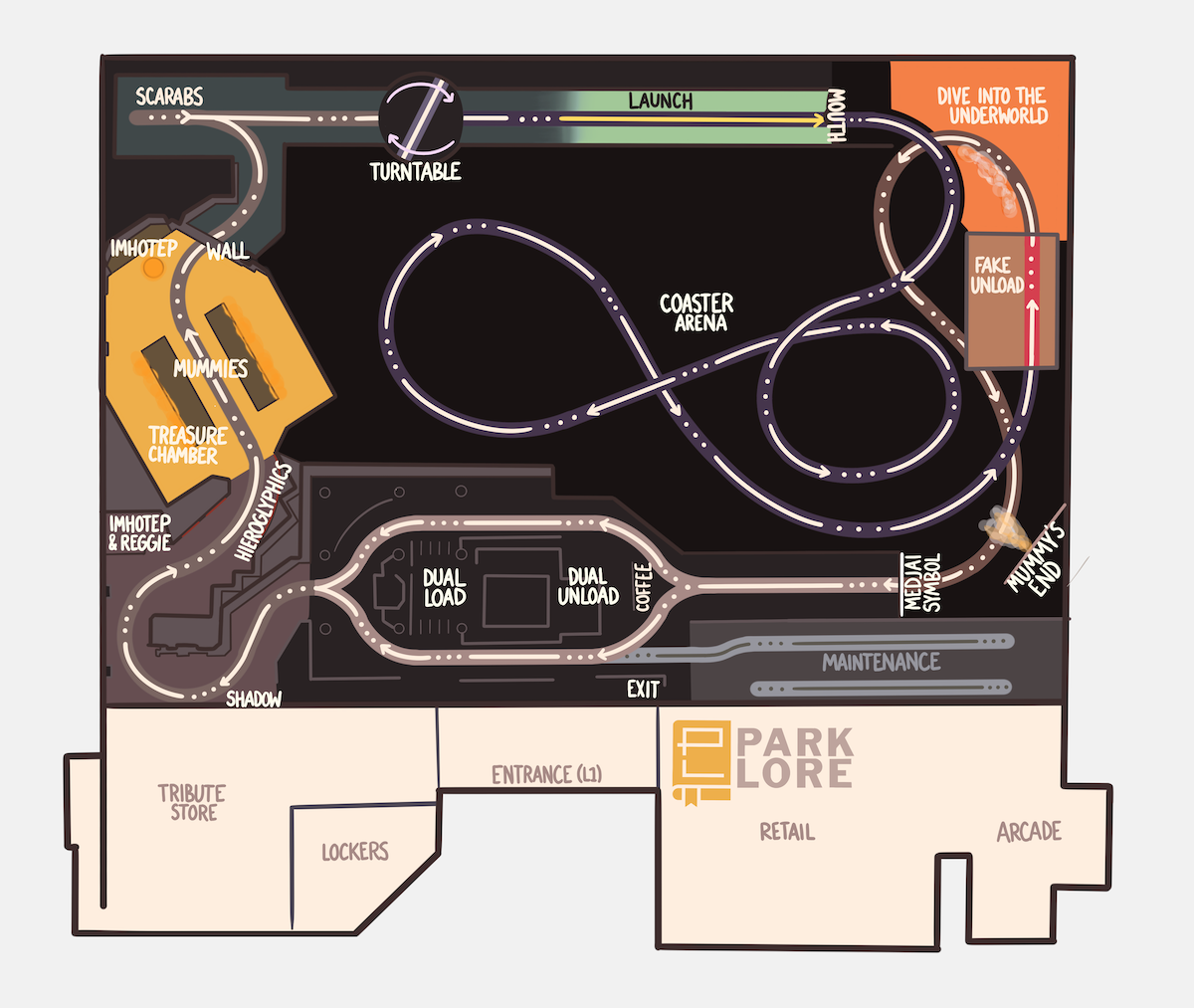
Billed as the world’s first “psychological thrill ride,” Revenge of the Mummy is packed with high-impact moments, including flames, jump-scare warrior mummies, near-miss illusions with booby traps, bugs, and an encounter with one of the Best Audio-Animatronics on Earth. It also includes some unexpected maneuvers, including a “dead end,” a short backwards track segment, a turntable, an uphill launch into Imhotep’s mouth, and a “Fake Unload Station” scene which teases riders into thinking it’s over before diving into a smoke-filled finale.
All of it adds up to a ride that’s a great mix of “thrills” and “theme,” a roaring good time that’s distinctly “Universal”, and a ride worth preserving in our Modern Marvels: Revenge of the Mummy in-depth feature. (Florida’s ride layout is copied in Singapore, though for better or worse, its scenes are slightly altered to account for a more “in-universe” story – i.e., no sequel-filming frame story, no “Reggie the P.A.” and no Brenden Fraser finale cameo.)
B. Revenge of the Mummy (Universal Studios Hollywood, 2004)
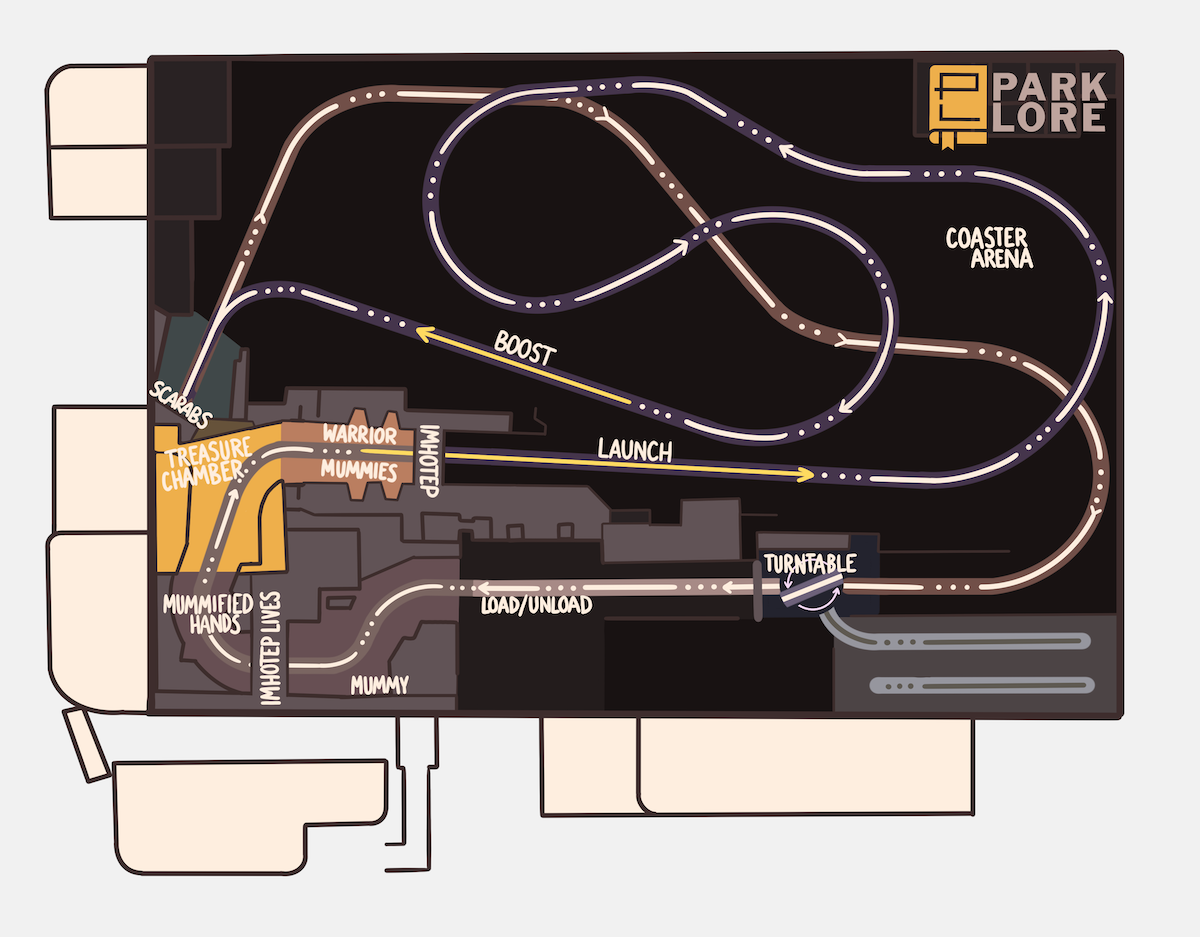
Universal Studios Hollywood added Revenge of the Mummy in 2004, too, but placed it in the showbuilding that once housed the park’s E.T. Adventure, which is slightly smaller (55,000 square feet) and much shorter, at just four stories tall. With a smaller space and a smaller budget, designers “made it work” by rethinking the ride from scratch.
Hollywood’s Revenge of the Mummy has a far shorter and less elaborate dark ride section, but a lengthier (though less intense) coaster section. Halfway through the coaster’s winding, twisting layout, it stops in a brief show-scene, then reverses. Whereas Florida’s backward section amounts to a small dip, half of Hollywood’s layout is experienced backwards, ending with an unusual anti-climax that restores the train’s direction just as it re-enters the unload station.
Revenge of the Mummy in Hollywood is still a fun ride, and has some surprises up its sleeve. But few would bother to argue that Hollywood’s Revenge of the Mummy is as good as Florida’s – much less better – which leaves some fans arguing as to whether the California park would’ve been better off just keeping E.T. Adventure in the space.
4. Soarin’, Around the World
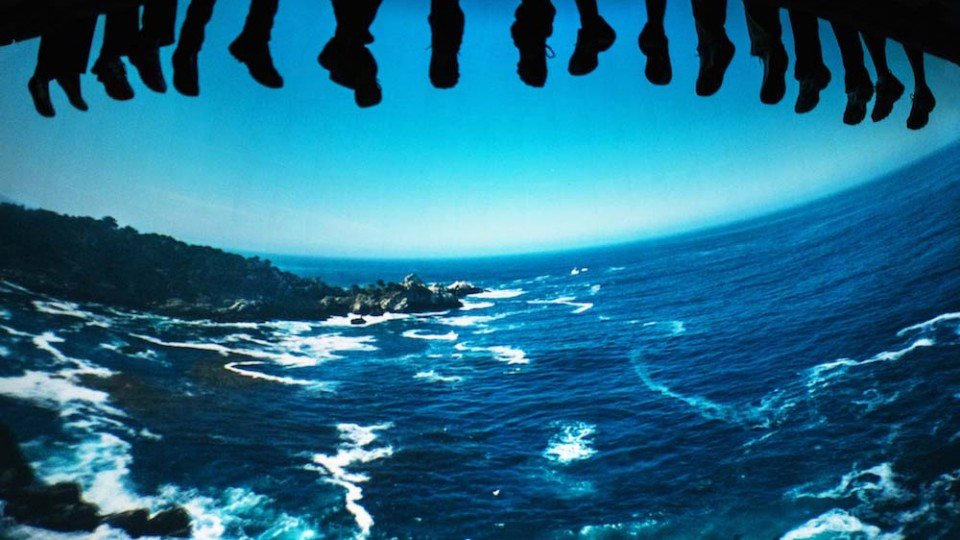
Soarin’ is doubtlessly one of Imagineering’s “modern classics,” mixing motion, music, and heart. It’s also a pivot point in the story of the Age of the Simulator. After all, Soarin’ let Imagineers create a new kind of motion simulator focused not on white-knuckle, jostling thrills, but on joy. The ingenious free-flying ride can now be found at four Disney Parks, to say nothing of the dozens of “flying theaters” that now inhabit amusement parks, malls, and tourist centers. But the layout of Soarin’ in its two U.S. installations also tells a story…
A. Soarin’ (Disney California Adventure, 2001)
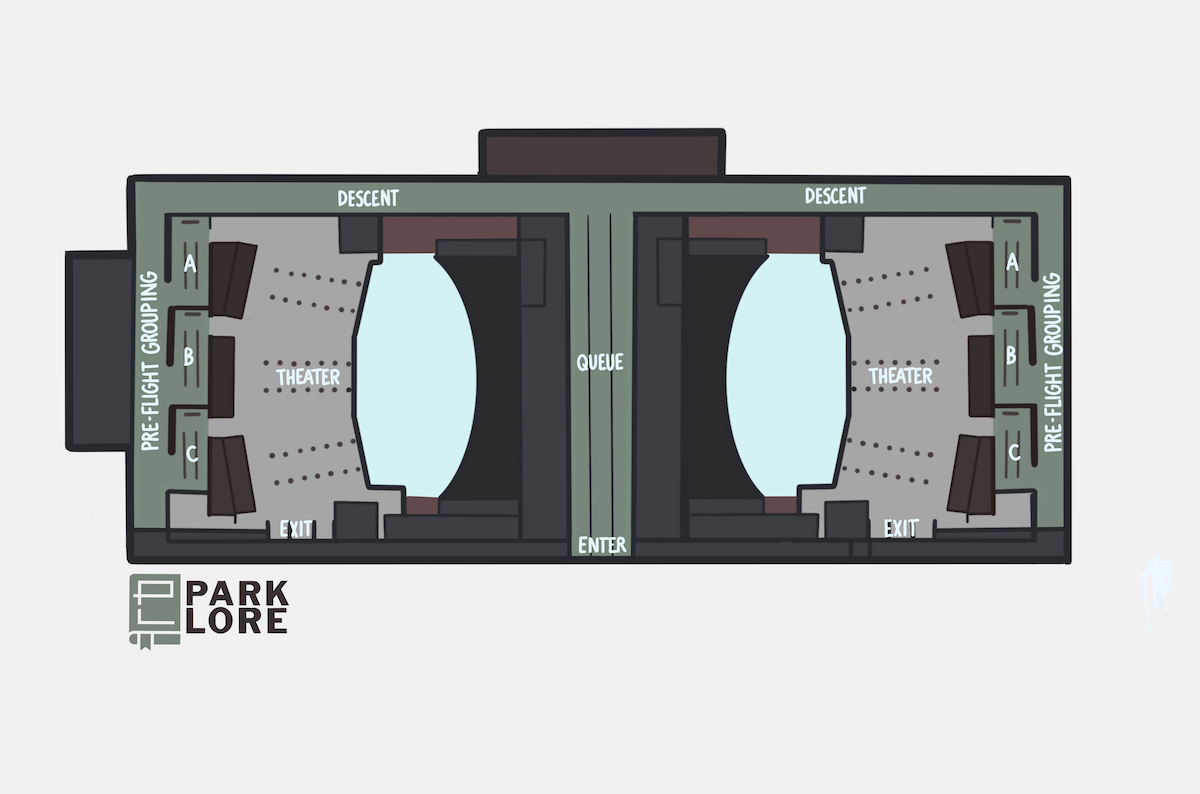
When the Lost Legend: Soarin’ Over California opened alongside Disney’s California Adventure in 2001, the novel ride was quickly understood as one of the new park’s few “Disney-quality” attractions. Its biggest innovation was its unique ride system, which allows 87 riders to load into “hang-gliders” on a single level before being swung out and stacked into a domed screen, giving everyone an aerial, front-row view.
The ride’s form follows its function. Two very large domed screens from two mirror-imaged theaters reside in the center of the showbuilding, necessitating an arcing shape to the building. Luckily, that shape happens to recall arcing airplane hangars, thus “disguising” the showbuilding in “plane” sight in the park’s Grizzly Peak Airfield. Both astoundingly complex and joyfully simple, Soarin’ was a hit and remains one of the park’s anchor attractions to this day – even if the current “Around the World” film is technically a strange fit for a California-themed park.
B. Soarin’ (EPCOT, 2005)

2005’s global “Happiest Celebration on Earth” Disney Parks promotion was inspired by Disneyland’s 50th Anniversary… but it’s Disney World that got the gifts – one attraction cloned from every resort. California’s contribution was a copy of Soarin’, still fresh from its launch as the only standout success of Disney’s California Adventure. The E-Ticket also meshed well with late-’90s, early-2000s recasting of EPCOT as Disney World’s “Discovery Park” of semi-scientific, technological thrills versus the dense dark rides of yesteryear.
Just like in California, the building that houses Soarin’s two mirrored theaters in Florida was shaped like an airplane hangar. But in Florida, most guests never notice it. Rather than being a standalone experience, the ride is just one offering within The Land pavilion. The new, auxiliary showbuilding was tucked away behind the Imagination pavilion and painted “blending blue,” so even though it’s visible from most of World Showcase, few consciously notice it.
Bulldozing through the space once occupied by the pavilion’s expired animatronic “dinner shows” – the Lost Legend: Kitchen Kabaret and its successor, Food Rocks – a glowing “airport terminal” queue was constructed to connect The Land to the new showbuilding. The walk to the ride became even longer for some when, in May 2016, EPCOT’s version opened a third theater (C), increasing the popular ride’s throughput by 50%… and just a month before its “Around the World” ride film debuted.



